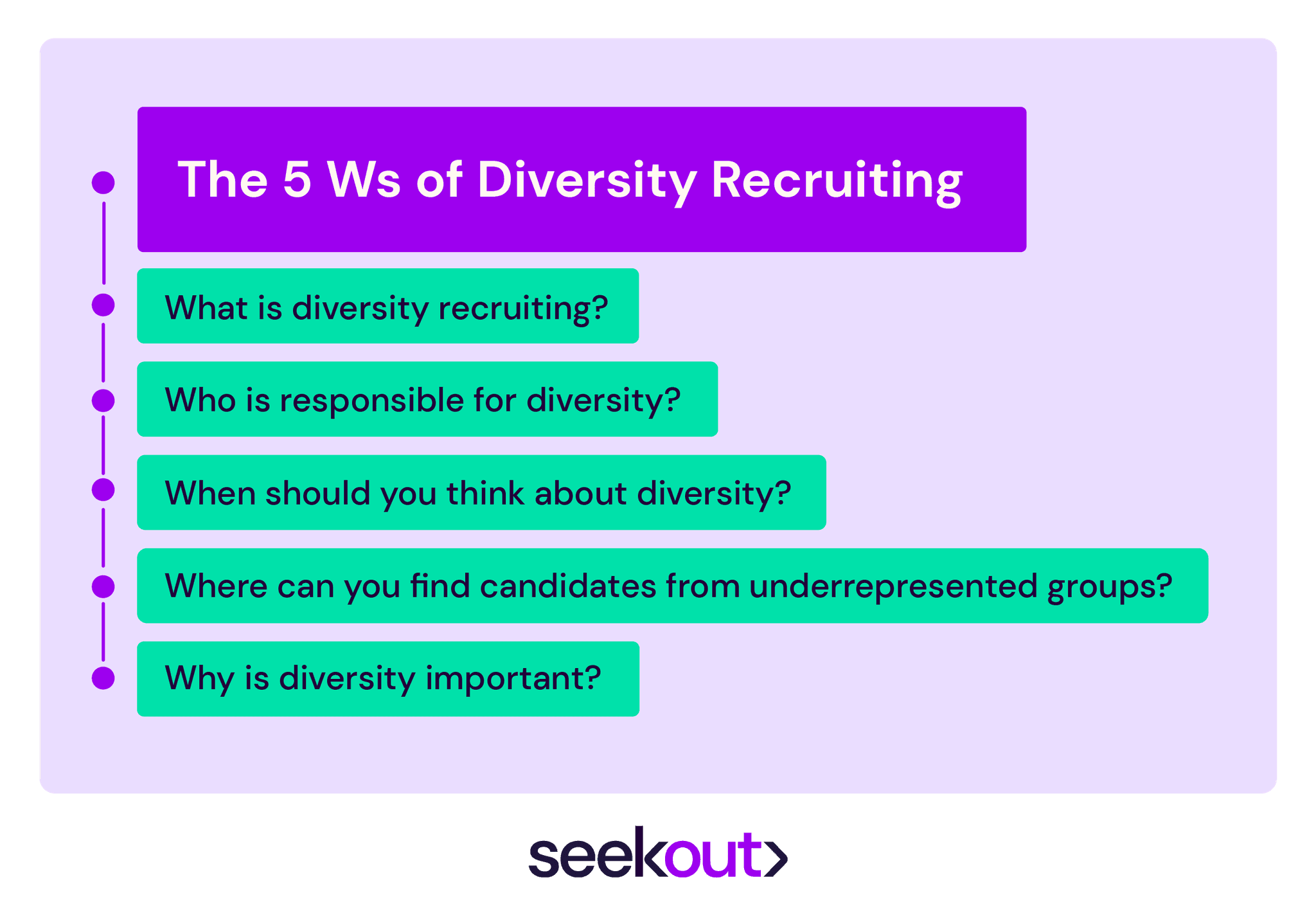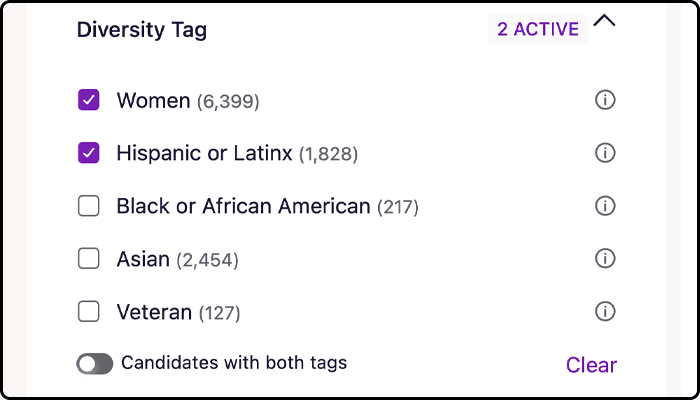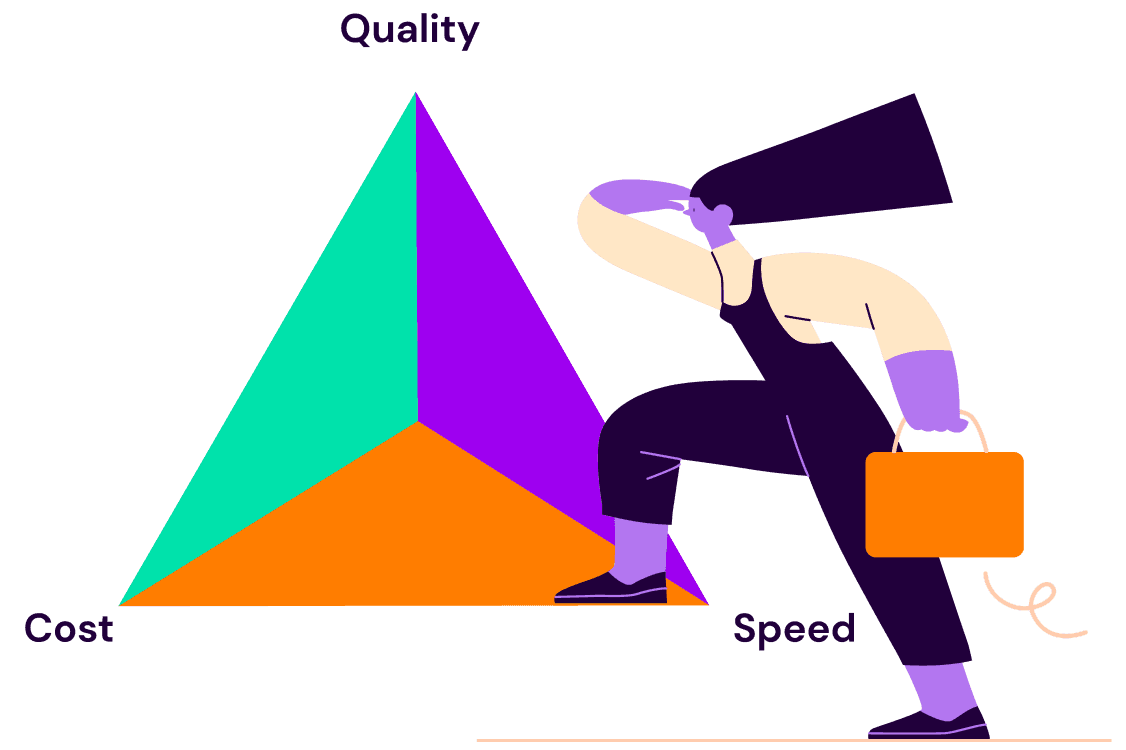
Back to blogs
Diversity recruiting has rightfully been the center of attention in talent acquisition strategies over the last several years. When companies prioritize diversity and inclusion, they experience benefits like improved innovation, higher revenues, and increased profitability.
Benefits to the business aside, diversity recruiting is the right thing to do. People from marginalized groups face many obstacles in the workforce, such as higher unemployment rates, lower wages, and overt harassment. Recruiting a diverse workforce can correct many of these injustices, and you, as a recruiter, have an important role in ensuring that your organization is leading the way in this movement. These 13 tips will help spark the creativity and thoughtfulness needed to build a successful roadmap.

Good to know: The terminology associated with diversity, equity, inclusion, and belonging (DEIB) is evolving. The following terms are beginning to replace "diversity recruiting." Read them as "recruiting for underrepresented communities" and "recruiting for underrepresented races and ethnicities."
Term | Description |
|---|---|
Underrepresented Communities (URCs) | Inclusive of all underrepresented groups (Women, Black, Latinx, Indigenous, LGBTQIA+, People with Disabilities, and Veterans) |
Underrepresented Races and Ethnicities (URRs) | Specific only to underrepresented racial and ethnic groups (Black, Latinx, Indigenous, and two or more races) |
1. Understand the five Ws of diversity recruiting
The five Ws of diversity recruiting are who, what, where, when, and why. The following questions can help guide your overall strategy and key performance indicators (KPIs). Keep in mind that answering these five Ws will take time and will require multiple conversations with input from different stakeholders.

What is diversity recruiting?
Diversity recruiting means recruiting for underrepresented or marginalized groups to add to your organization. Diversity can mean differences in age, neurodiversity, race, experiences, values, education, and much more. The aim is to ensure that your organization is employing diverse people internally to reflect the world we see externally.
Bring your leadership teams together to understand what diversity means to the organization. What does diversity at your organization look like today? Work on establishing goals, so you have a clear understanding of where work needs to be done.
Who is responsible for diversity in your organization?
It’s everyone’s responsibility to ensure that an organization is inclusive. Implementing successful, ongoing initiatives starts with executive sponsorship and buy-ins. These initiatives can then be implemented in the organization’s culture where employees can feel seen and heard. A culture shift to inclusivity will take time, but work to establish a relationship with leadership where they understand the importance of taking ownership of diversity efforts. This will ultimately keep your recruiting diversity goals consistent and top of mind for everyone.
When should I start looking for diverse candidates?
Diversity recruiting isn’t a once-in-a-while thing—you should strive to build diverse candidate pipelines consistently. Incorporate your diversity recruiting strategies into your existing efforts to keep your funnel full of diverse candidates. Nurture these talent pools often so you can tap into those candidates when you’re ready to hire. (More on this further below.)
Where can I find candidates from underrepresented groups?
Finding people from underrepresented groups isn’t complicated, but it does take work. For example, if you’re looking for a junior software engineer, you might post a job to a university’s Latinx student engineers club to reach soon-to-be graduates of that community. Universities, professional groups on LinkedIn, career fairs, network referrals, etc., are all worth exploring to reach the people you’re looking for. Discuss with your team where to place your efforts.
Also, this is where diversity recruiting software will save you time. Search engines like SeekOut can help you discover and connect with common organizations and communities that people from underrepresented groups are connected to. Jackye Clayton, VP of Talent Acquisition and DEIB at Textio, and her team use this tactic to build personal, more meaningful connections with candidates outside the confines of social networks.
Why is diversity important?
Understanding why diversity is important to your organization is essential in guiding your overall strategy and will ultimately help get buy-in from leadership. For example, frame diversity and inclusion efforts as a key business function, showing how major business priorities will be impacted: How will hiring a diverse workforce impact your organization’s bottom line? How will diversity initiatives improve innovation? How will diversity initiatives increase revenue?
Emphasizing empathy can also encourage buy-in. As we strive to make this world a better place, where does your organization stand? How can your organization set an example to others in your industry?
2. Position yourself as a talent advisor
One way to ensure that your team is staying on course with recruiting diversity efforts is to start thinking about positioning yourself as a talent advisor—someone who is strategic and future-oriented rather than someone who simply fills job openings.
When you position yourself as a talent advisor, you become a voice of reason to hiring managers and someone they turn to for guidance when approaching new roles. For example, when hiring managers come to you with strict job requirements that you know aren’t conducive to finding diverse talent, you can make recommendations about how to broaden the requirements and add adjacent skill sets to cast a wider net. You’ll help hiring managers discover diverse, talented people they wouldn’t have otherwise found had they kept their initial pool so small.
3. Leverage data to set and achieve your goals
Do you know where the most female software engineers went to college, where most veterans live, or which of your competitors has the most diverse workforce? The right data can help you answer these questions so you and your team can strategize and set realistic expectations with hiring managers and company leaders.
Talent acquisition platforms like SeekOut give you a bird’s eye view of any talent pool. The People Insights feature offers data about competitors, skills, and education that are commonly held for various job titles, top locations for diverse candidates, and much more. You can even print and export your insights to share with hiring managers.
4. Be authentic about your diversity recruiting efforts
Being authentic means being honest and realistic with candidates about your existing diversity efforts—even if you still have a lot of diversity and inclusion work to do. Start by focusing on your website, specifically your About Us and Careers pages (or the equivalent). If you don’t have a diverse team right now, own that and let candidates know you’re actively working to change it.
Here’s where to start:
Publish a diversity statement. Candidates want to see a diversity statement that pledges your commitment. Make it meaningful by including goals and showing how you’re taking action.
Stay away from stock images. Use real people from your organization on these pages. Share pictures of your team from company events and around the office.
A transparent view of your company culture will make a strong first impression with diverse talent and encourage engagement.
5. Write inclusive job postings
When job postings don’t incorporate inclusive language, it discourages those from underrepresented groups from applying. For example, men will usually apply for a role if they meet 60% of the qualifications, while women will only apply if they meet 100% of the criteria.
A few ways to encourage people from all backgrounds to apply include sticking to must-have skills, striving for gender-neutral language, and removing educational requirements when possible. There are so many other best practices to consider. Establish with your team what yours will be and revisit them often.
6. Research diversity recruiting tools that will help you meet your goals
The time required to recruit candidates—let alone diverse candidates—is time consuming, so rely on your tech stack to expedite the process and help you make smarter choices along the way. With the right tools, you can quickly source, engage, and ultimately hire more inclusively in less time.

Artificial intelligence (AI) has made it so much easier to recruit diverse candidates. For example, SeekOut helps you find candidates from different backgrounds, including Women, Hispanic or Latinx, Black or African American, Asian, and Veterans with AI-powered search filters. Candidates don't typically list their diversity status online, but SeekOut’s machine learning classifiers use various attributes found on candidate profiles—such as names, educational history, and group membership—to make the best guess for each candidate.
7. Build relationships with potential candidates before you need to hire
Diversity recruiting efforts tend to take a backseat when you’re under pressure to hire a candidate quickly. This is why it’s crucial to get to know diverse candidates ahead of time so that when a hiring manager comes to you about filling a role ASAP, you already have a pool of diverse, engaged candidates to reach out to. This diversity recruiting tactic works well for evergreen roles you hire for frequently. Once you’ve found stellar candidates, send an email that shares why you're interested in them.
Introduce yourself and your organization. Offer insight into the company and its culture and show them where to learn more on your website.
Get to know them. Let them know why you chose to message them, what talent or skills stand out, and how working for your organization could support their career.

GPT-powered tools like SeekOut Assist can speed up finding candidates and sending outreach messages. Upload a job description and SeekOut Asist will instantly create an initial search you can review and edit. When you find the right candidates, SeekOut Assist will generate a drafted message based on the candidate’s profile, the job description, and the search requirements used to find the candidate.
Building relationships with candidates takes time, so don’t let this first email get too overwhelming. Take it step by step and pace out your messages.
8. Unlearn your unconscious bias
Don’t let unconscious biases sabotage your diversity recruiting efforts. We can’t eliminate unconscious biases completely, but we can learn to identify them. A few things you can do include:
Anonymize resumes. Create blind resume reviews that hide identifying information. While worth the effort, this task is time-consuming to do manually, but tools like SeekOut’s Bias Reducer can do this instantly for you.
Enforce the Rule of Two. Aim to have at least two qualified diverse or underrepresented candidates among the choices you offer to your hiring manager.
To set everyone up for success, take unconscious bias training to understand potential areas where bias may appear in the hiring process and how to be proactive about solving it.
9. Determine your KPIs to measure success
The best way to determine your strategy’s effectiveness is to establish KPIs. Get your team together to determine what matters most to you. Questions you could ask include:
Are you attracting a more diverse group of applicants?
Have you improved hiring women in tech but found less success hiring from other communities?
Are you losing candidates at specific stages in your recruitment process?
AI recruiting software can help you keep track of some common diversity recruiting KPIs, such as breaking down your talent pipeline by underrepresented groups.
10. Iterate your diversity recruiting strategies often
There’s no one-size-fits-all in diversity recruiting. What generates a diverse slate of candidates for one company, department, or group may not be successful in another. And what worked well last year may not work well this year. You may find, for example, that your best candidate source for hires for the last several years has stopped performing well. Continually assess your diversity recruiting processes to understand what’s working, what needs improvement, and what you should stop doing altogether.
Enforce the routine to revisit your strategy by scheduling it on your calendar, for example, where you compare your efforts against a chosen time frame (i.e., year over year, quarter over quarter).
11. Make diversity recruiting part of your daily routine
As you’ve already gathered, diversity recruiting is not something you can tackle all at once, and it’s not something you can “set and forget.” To boost your chances of success, make diversity recruiting part of your daily routine. Dedicate time to ensure that you’re attracting and retaining diverse candidates so that it eventually becomes a natural part of your overall recruiting strategy. Aim for consistency. For example, you could set a few daily goals for yourself, such as reaching out to two diverse candidates to add to your pipeline or setting aside time to research diverse organizations that you collect into a growing list.
12. Look to existing employees to fill open roles
When you have jobs to fill, look to the talent already within your company. Let your employees know of open roles as they become available and encourage them to apply.
This tip speaks to a greater internal mobility and upskilling strategy that you’ll want to develop to retain your diverse talent: according to a study by Gallup and Amazon, 48% of American workers would switch to a new job if it offered skills training opportunities. When you give employees the resources and time to advance their careers, your organization is being proactive with diversity recruiting. For example, you're giving employees the opportunity to get hired for a new role based on their skills and less on “knowing so-and-so" at the company.

Suggested reading: Keep Your Best Talent: 7 Strategies to Drive Internal Mobility
13. Look ahead to your interviewing process
If you have a diverse talent pool but find that you’re still not hiring candidates from underrepresented groups, your interview process could be to blame. Aim to reduce unconscious bias with your hiring team and ensure that interviews are consistent for every candidate. Let the hiring team know what you’re doing to enhance diversity at your company so these goals can be top of mind when they’re reviewing applicants.

Final note: Diversity recruiting is only a component of a healthy, impactful DEIB workplace strategy. This blog post is not intended to be an all-encompassing resource; instead, you can use it to discover ways to set your overall recruiting strategy in the right direction. Each tip we’ve presented requires more research and exploration to properly implement.
Use SeekOut to reach your diversity recruiting goals
While diversity recruiting should be a critical component of every organization's talent strategy, many lack effective tools to find qualified candidates from underrepresented groups. SeekOut offers powerful solutions and deep expertise to recruit diverse candidates. We help customers expand their funnels and improve representation across talent pools while addressing unconscious bias in the hiring process.
See us in action
Learn how SeekOut unifies people data to help organizations reach their talent goals
Request a demo




